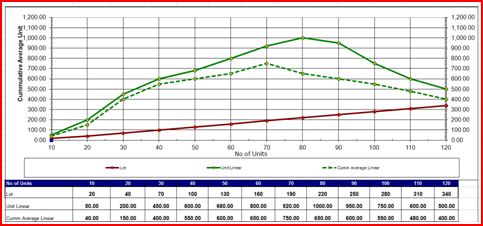1. Problem recognition, definition and evaluation
The underlying principle of learning curves is that the more often a worker repeats a given task, the more efficient he becomes. Hence, the problem statement is to determine which learning curve method is best suitable for effective project delivery with repetitive tasks planning and implementation.
2. Development of the feasible alternatives
Two types of learning curves are typically applicable in construction projects with repetitive activities:
1. Unit Learning Curves
2. Cumulative Average Learning Curves
Unit Learning Curve: The value of each unit follows the constant rate rule. Thus, if unit 10 is expected to take 100 hours to complete, unit 20 is estimated to take 80 hours, assuming an 80% learning curve slope.
Cumulative Average Learning Curve: The cumulative average value through a unit follows the constant rate rule. The cost of manufacturing or installing a unit decreases as the number of units involved increases:
It was observed that as the number of units doubled, the unit value or cumulative average value tended to be a constant percent of the value of the unit number that was doubled. The constant percent reduction is called the slope. This relationship is represented by the following equation:
Yx = T1 x (X)b ;
Where T1 = theoretical or estimated value of first units,
X = the unit being calculated,
b = the exponential value associated with the slope.
When the estimated improvement rate for completing a task is plotted versus the number of units produced, the display is a curve which decreases to the right as the number of units increases:
Above curve shows an 80% unit learning curve plotted in normal coordinates.
4. Selection of the acceptable criteria
Factors that must remain constant for learning curves to be meaningfully applied include;
a. The work is similar and repetitive.
b. The same people and supervision are involved in the process.
c. Avoid frequent starts and stops, with lag time in the middle that could cause loss of proficiency.
d. There are no significant delays between repetitive activities.
5. Analysis and Comparison of the alternatives
Calculation results for both methods:
6. Selection of the preferred alternative
The principle of the cumulative average learning curve is that when a process or operation is done repetitively, those performing the operation will become more proficient over time and so the cost per unit will decrease, as shown in table above.
7. Performance Monitoring and Post Evaluation of Results
Based on the tabular evaluation, for the cumulative average learning curve to be meaningful, there should be a continuity of the production cycle. If there is a break in continuity, there would be some loss of learning improvement, which could result in significant cost overrun and loss of credibility.
8. References/Bibliography
1. Hartley, H.K. (1965), The Journal of Industrial Economics,
The theory of learning as used in the Aircraft Industry states that direct labor learns as it works-the more often a worker repeats a given task, the more efficient he will become. Retrieved from: http://www.jstor.org/discover/10.2307/2097667?uid=17372520&uid=3738032&uid=16739312&uid=2&uid=3&uid=67&uid=62&sid=21101492738607
2. Humphreys, K.K. (1991), Cost and Optimization Engineering, 3rd ed., the accountant' s application of depreciation for each year is called a ..... Learning curve as a function of the gain for double the production. Retrieved from: http://www.crcnetbase.com/doi/abs/10.1201/9780849390388.ch1


AWESOME, Austin!!!! Loved your case study, loved your treatment of it and best of all, your citations were PERFECT!!! WOW!!!!!
ReplyDeleteBecause you have demonstrated such a good grasp of this concept (which I can almost guaranty you WILL be on your CCC/E, CEP and PSP exams) could I interest in you in MENTORING Livinus or someone else who is struggling?
The case study I would recommend is to apply learning curve to your BLOG postings. By now, most people have had at least 3 or 4 and based on how long it took to do those, apply learning curve theory to see how long it will take to prepare and post your 25th one?
IF you are willing to mentor someone who is struggling I will give you BOTH credit.
BR,
Dr. PDG, back in Jakarta